
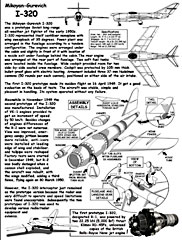
Mig-I-320

The Mig-I-320
In January 1948, the Soviet Union issued a specification for a long-range, all-weather fighter, capable of intercepting hostile aircraft far from the attacker's targets by day and night. The specification resulted in designs from several design sources, including Mikoyan-Gurevich, who proposed the Izdeliya R ("Article R")or I-320,
This design, was like the other two competing aircraft, a twin-engined swept-wing aircraft, with the fuselage housing the engines in tandem, with one at the bottom of the forward fuselage and the second in the rear fuselage. The engines were fed from an inlet in the nose, which spilt into three ducts, the first feeding the forward engine and the other two passing around the cockpit to feed the rear engine. The crew of two (aircraft commander and radar operator, who were provided with dual controls) sat on individual ejector seats in a side-by-side, unpressurised cockpit.
The wings, which were of similar layout to those of the smaller MiG-15 day fighter were swept at an angle of 35 degrees, and were fitted with large wing fences. Air intercept radar, at first Toryii and later the much improved Korshun, was fitted in a radome in the upper lip of the air intake.
The first prototype, designated R-1, was powered by two 5,000 lb
thrust Klimov RD-45Fs, (unlicensed copies, of course, of the British Rolls-Royce Nene engine), and was armed with two Nudelman N-37 cannon, positioned on either side of the air intake. It made its maiden flight on 16 April 1949. A second prototype, R-2, which differed in having more powerful Klimov VK-1 engines, a third N-37 cannon and an improved windscreen and canopy followed in November 1949. Model R-2 was badly damaged when a cannon shell exploded, and the aircraft was rebuilt, with the wings modified, adding a third fence, flying again as the R-03 on 30 March 1950.
No production followed, as the specification to which the I-320 was built was superceded by a later requirement that led to the production of the Yakovlev Yak-25 (right). The two prototypes continued in use by the MiG design bureau as testbeds for the development of avionics.
 |
It is true that the Russians (and definitely the Americans !!) copied many German aircraft and this is pretty much the case here.The engines in the fwjp045 were side by side below the fuselage and in the MiG I-320 one engine was below the fuselage and the other in the rear fuselage.. |
Specifications Mig I-320 (R-2/3) |
|
| Crew: 2 | Length: 51 ft 9 in |
| Wing area: 443 sq ft | Wingspan: 46 ft 7 in |
| Empty weight:16,446 lb | Max speed: 677 mph at sea level |
| Gross weight:23,645 lb | Range: 749 mi |
| Max T.O. Wt 26,665 lb | Service ceiling: 50,853 ft |
Guns: Nudelman N-37 cannon |
|
Aerodynamically, MiG I-320 or Aircraft R resembled the MiG-15, the wing having the same airfoil profile and sweep, the same pairs of fences and similar boosted ailerons. Differences were that the anhedral was -3° instead of —2°, the CAHI/Fowler flaps were extended 011 tracks parallel to the longitudinal axis to the increased angles of 22° for takeoff and 56° for landing, and that roll induced by rudder deflection was countered by fitting narrow interceptors (in effect, spoilers) on the underside of the wings ahead of the ailerons. With a span of 35.4in, these were opened electrically as soon as rudder deflection exceeded 2°.
The MiG I-320 ruling diameter of the forward fuselage was 74.8in. Like previous MiG interceptors, the scanner for the Slepushkin Toriy-A (thorium) radar was to be housed in a radome at the top of the nose, though the radar was not ready for the R-l prototype.
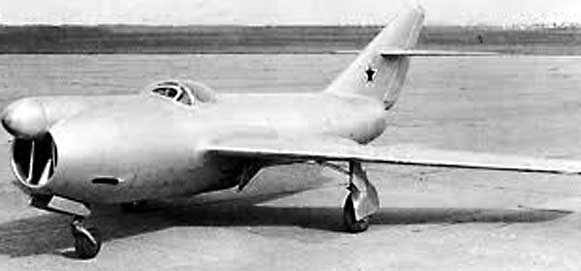 |
Development of the I-320 was discontinued when the requirement was overtaken by a more advanced one. Just as well, because THIS PLANE IS UGLY :) |
The circular inlet was divided into three, the central duct feeding the plenum chamber housing the front RD-45F engine and the side ducts passing on each side of the cockpit to the plenum chamber for the rear RD-45F. Apart from the complex air ducts, the engine installations were reminiscent of the MiG-9 (front engine) and MiG-15 (rear).
The MiG I-320 tail was again reminiscent of the MiG-15, but the enormous fin had a leading-edge sweep increased to 59°, and the relatively small tailplane had a leading-edge sweep of 40°. As before, the elevators were tabbed and had mass balances at the tips, and moved with hydraulic boost from 17° down to 33° up. The upper and lower rudders were internally balanced, the lower having a ‘knife’ strip on its trailing edge. The rudder limits of travel were ±24°48?. The airbrakes were larger than those of the MiG-15, each having an area of 11.6sq ft driven open to 45°.
Again, the landing gear resembled a strengthened version of that of the MiG-15. The nose unit had a levered-suspension leg carrying a castoring wheel. It retracted forwards into a narrow bay with a streamlined cover projecting into the center duct. The main legs were pivoted at the junction of the main and transverse spars, as in the MiG-15, the track being no less than 17ft 10in. Wheelbase was 15ft 7.1in. Each unit had a levered lower arm carrying a wheel with a two-shoe drum brake. The unit retracted inwards into the wing, the bay being closed by doors on the leg and a door hinged under the wing root.
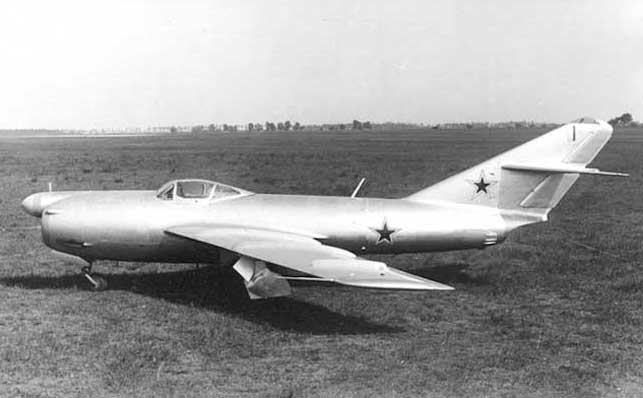 |
Two prototypes of MiG I-320, R-1 and R-2, were built. The R-l was first flown on 16 April 1949 and the aircraft handled well, the only problems being a repetition of the MiG-15 difficulties of wing drop (between 930 and 578-584 mph) and roll instability around Mach 0.895. This prevented it from being certified. |
The cockpit was unpressurized, and covered by a windscreen with two flat front windows each 4.13in thick, and a wide aft-sliding canopy. It housed two pilot stations side by side. Each had an OKB-developed ejection seat (MiG-15 type), a complete set of instruments and a visor-type radar display, and controls for the aircraft, engines, systems, radar and armament. The left seat was intended to be occupied by the captain, and the right seat by the radar operator. The captain was to manage the mission, fly the aircraft and fire the guns, while the right-seater was to use the radar to guide the captain to targets and share the flying on long patrols.
The requirement ignored any alternative mission, and no provision was made for underwing stores apart from tanks. Armament comprised two N-37 cannon, one on each side of the forward fuselage with the muzzles well behind the inlet. Originally the magazines under the cockpit floor held 50 rounds each, but this was later increased to 60. Fire control was electrical, and the guns were cocked pneumatically.
The same compressed-air system controlled the brakes on the main-wheels, but (apart from the spoilers) all other secondary power was hydraulic. The Main and Emergency systems operated the landing-gear units and their doors, the flaps, and the boosters on the ailerons and elevators. Fuel was housed in two bladder-type cells in tandem between the cockpit and the rear engine. The front tank had a capacity of 367.4gal and the rear tank 358.6gal including a small separate section which continued to feed the engines under negative g. Thus, total capacity was 726gal. The wings were designed for drop tanks.
Load factor was originally 5.9g up to a weight of 18,805lb, but during the design process it was increased to the same 8g value as the MiG-15.
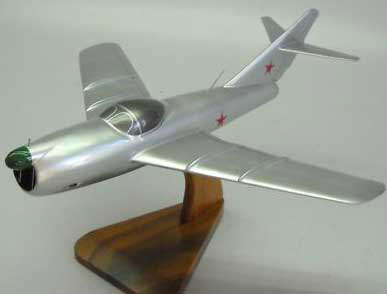 |
A nicely designed mahogany model of the Mig-I-320 |
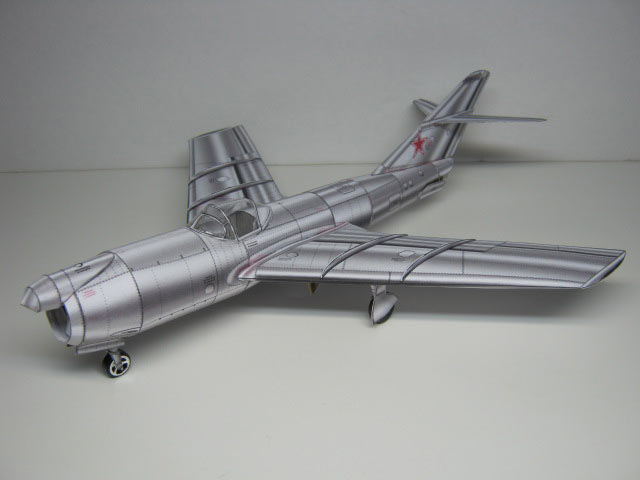 |
An even MORE nicely designed model of the Mig-I-320 out of paper. Designed by Vlad and built by Bob Martin |


